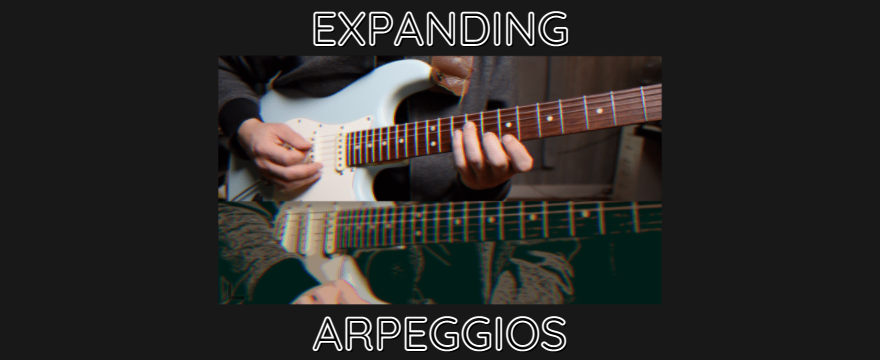Expanding Arpeggio Skills is a lesson to stretch your abilities and give you a path to move across the neck over a single chord. This video expands on the previous lesson I released here, which went into the basic root position three octave arpeggio shape.
Today’s video expands the idea to include the first inversion shape, as well as the root position.
Arpeggios are my best friend
There are a few basic building blocks of music. You’ve got scales, which give birth to arpeggios and chords. Arpeggios and chords are just the same thing from two different perspectives, you could say.
I put a lot of time and effort in my practice to work on arpeggios, and there are a two main reasons for this.
By practicing arpeggios I can infuse my playing with more “vertical” or “intervallic” sounds.
This is in contrast to the way it sounds when I play solely using scales, or notes that are adjacent, or right next to each other.
I, as well as most players, began by learning to improvise using scales. So for me the scalar approach is more deeply ingrained, which is why I have spent a lot of time working on adding more of the vertical elements to my playing.
To my ears, vertical/intervallic playing has a less predictable and more colorful sound as compared to a primarily scale based approach.
By knowing my arpeggios, I can outline chords.
Outlining chords makes you sound like a pro, rather than a flailing noodle. Disclaimer: You will only sound like a pro if your rhythm is very good. Practice your rhythm. Want ideas on how? Check out this lesson on rhythmic time feel
Playing over chord changes is freaking hard. It was especially frustrating when it was brand new to me. I learned that if I tried to follow chords that went out of a key, it was nearly impossible for me to think fast enough.
I felt like there was no way that I could know what scale or mode to play over any given chord, if it wasn’t in a single key. But, by using the arpeggio of each of the chords as an anchor to play notes that sounded right, I was able to start improvising over more challenging chord patterns.
It was of course difficult at first, but it worked. I slowly got used to more challenging chord patterns by using my arpeggio/chord shapes as a guide.
Once I could improvise with the arpeggio then there was room to explore the notes that surrounded it. Then I was able to tap into the scales that went with each chord.
My point is… ARPEGGIOS FIRST!!! Sorry for yelling.
So there you have it, my two main reasons for drilling arpeggios constantly.
Expanding Arpeggio Skills
I hope you enjoy exploring the three octave arpeggios that I use in this lesson. I hope they help you expand your repertoire and start jumping around the neck like it ain’t no thang.

Leave a Reply
You must be logged in to post a comment.